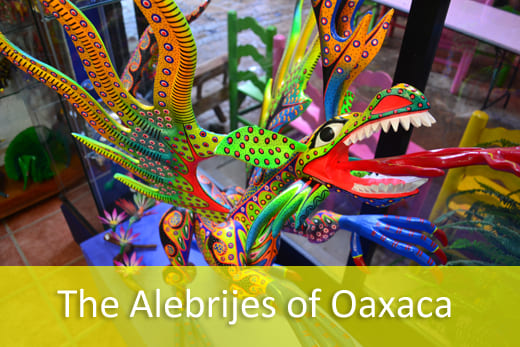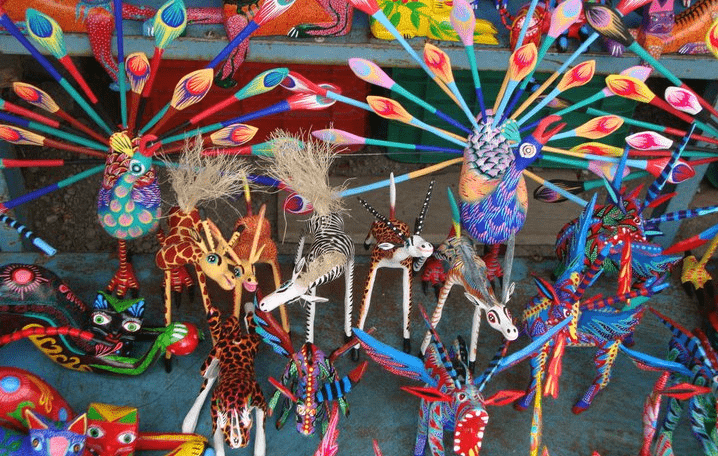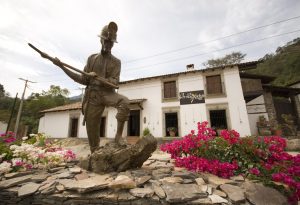
#MexicoToday – During our recent visit to Oaxaca for the Mexico Today program, Chase and I experienced a total cultural immersion. Visiting the ruins of Mitla, learning about Zapotec ancestry and experiencing La Calenda and La Guelaguezta – every minute of the trip our senses were captivated. The sights of all the colorful dresses, the sounds of the band leading the parade, the taste of the finest Oaxaca cheese, the smell of rich mole, and the feel of everyone’s vibrant energy radiating, all combined to make Oaxaca astounding.
Because Oaxaca is so rich in culture, it serves as a well representative of Mexico as a whole; however, one craft in particular has come to represent the spirit of Oaxaca: the Alebrije. Alebrijes are carved and painted animal figurines that have become a form of symbolic art important to the existence and development of the small villages that produce them. The word alebrije means “imaginary” or “fantasy,” describing a style of animal carvings with exceptional paint schemes. There are 3 main villages that are known for producing these colorful figures and luckily enough, a visit to San Martin Tilcajete was part of our program. The role alebrijes play in the local culture of Oaxaca was immediately evident upon entering the small village as the giant entryways were painted in the brightest of neon colors and doors were carved in the shape of whimsical animals.
When we arrived to the workshop of Jacobo and Maria Angeles (renowned masters in the art of carving and painting) , it was clear that San Martin Tilcajete were proud producers of the Alebrije. Unlike modern workshops, the Angeles family does not use synthetic paints, rather natural colors derived from nature. The skills to create these masterpieces were passed down through the family; Jacobo gained proficiency in wood carving from his father and Maria came from a line of painters. A progressing art continually altering due to demand, Jacobo and Maria have developed their skills in the intricacy and variation of each piece, raising the bar of quality for other villagers.

Alebrijes found outside of Mitla
Once I returned home from Oaxaca, my stimulation and interest for alebrijes grew as I stared at my hummingbird alebrije made by Jacobo. I was interested in how to distinguish a “true” and “authentic” alebrije as the work produced by the Angeles family was not duplicated or common. You can buy Oaxaca alebrijes all over Mexico in all different design styles, but how can you tell an imposter? The truth is, there is no one way an “authentic alebrije” should look. Alebrijes actually originated in Mexico City and were made of paper mache, trickling its way to Oaxaca, the art manifested into wood carvings and the name remained ‘alebrejies’. What is traditional and authentic is the carving of the copal wood. The extent of quality or design does not diminish its authenticity; it’s purely a unique work of art.
That being said, there are those who have tried to replicate and mass produce the alebrije out of foreign materials in foreign countries like China. When Jacobo Angeles realized that some of his customers where actually trying to exploit his craft, he started a legal battle to protect the native ritual, which he is still fighting today. Speaking at a panel discussion during our visit, Jacobo explained to us that his goal is to establish an official stamp of authenticity to be used not just for alebrijes, but for all traditional Mexican crafts.
For those interested in learning more about Jacobo’s alebrijes and his fight to preserve his family’s tradition, please visit tilcajete.org.
Alebrije’s continue to gain popularity as collectors and tourists from all over the world are drawn to the beautiful pieces. As with any piece of artwork, each carving tells it’s own story and it was truly a fascinating experience be able to visit one of the workshops and meet the carvers and painters. Oaxaca has many traditions it preserves and there is no better way to discover some of Mexico’s best customs than starting with Oaxaca.





